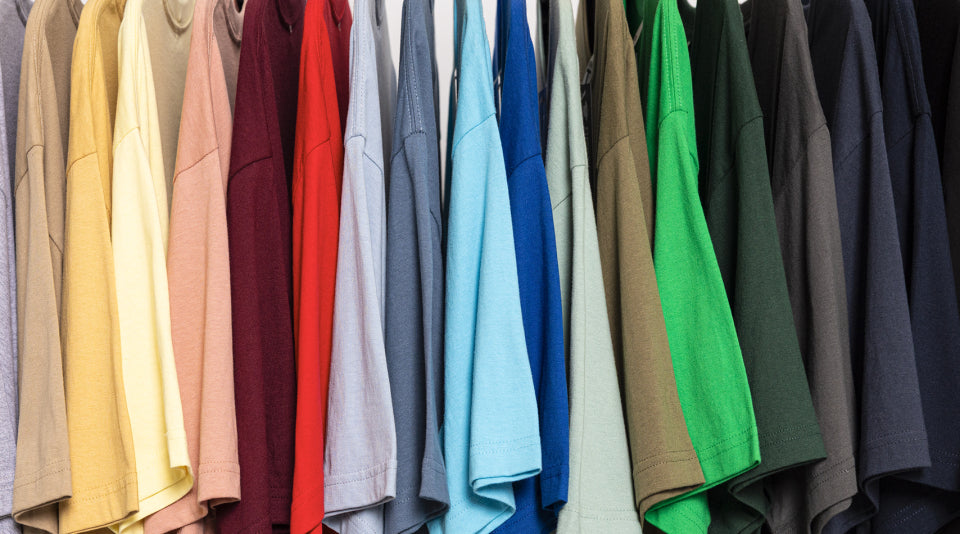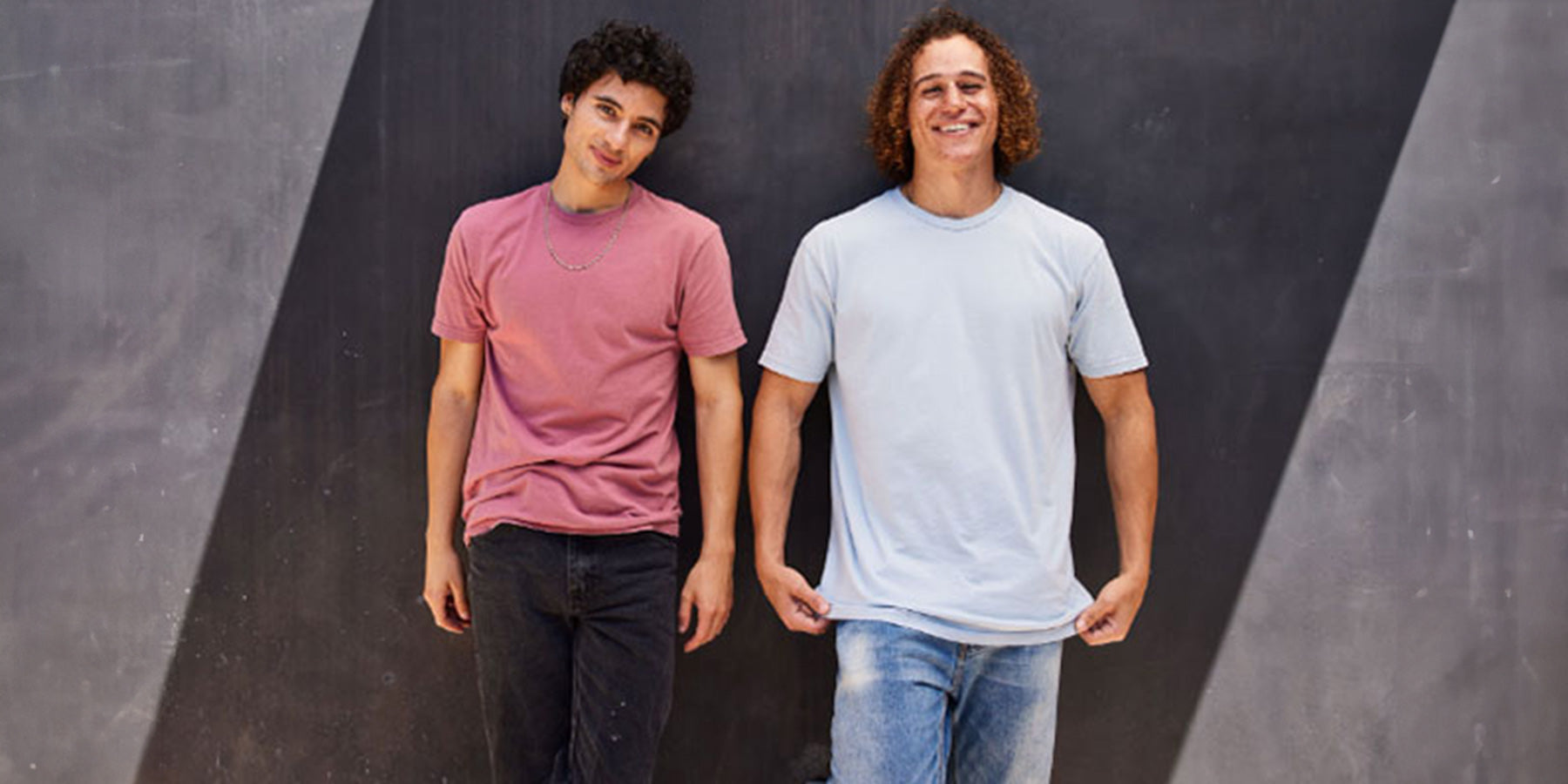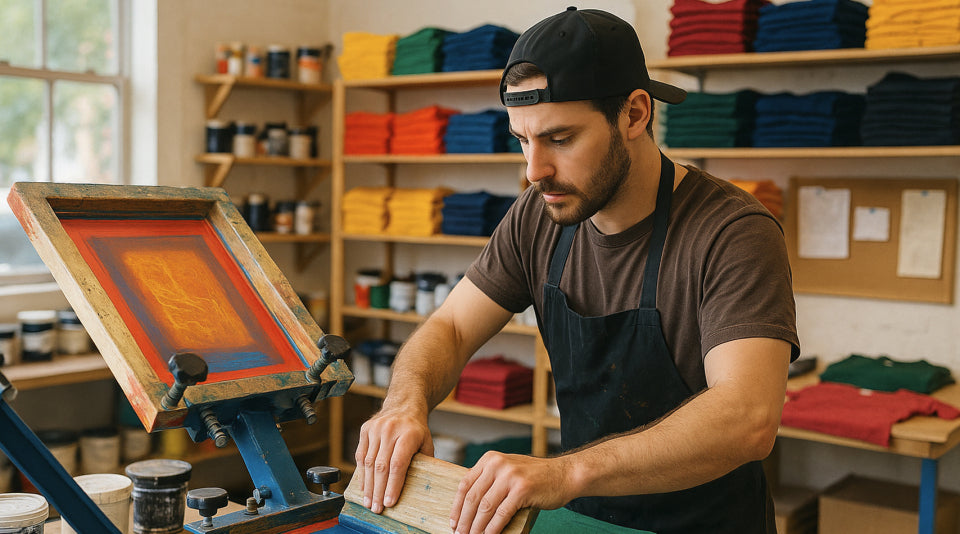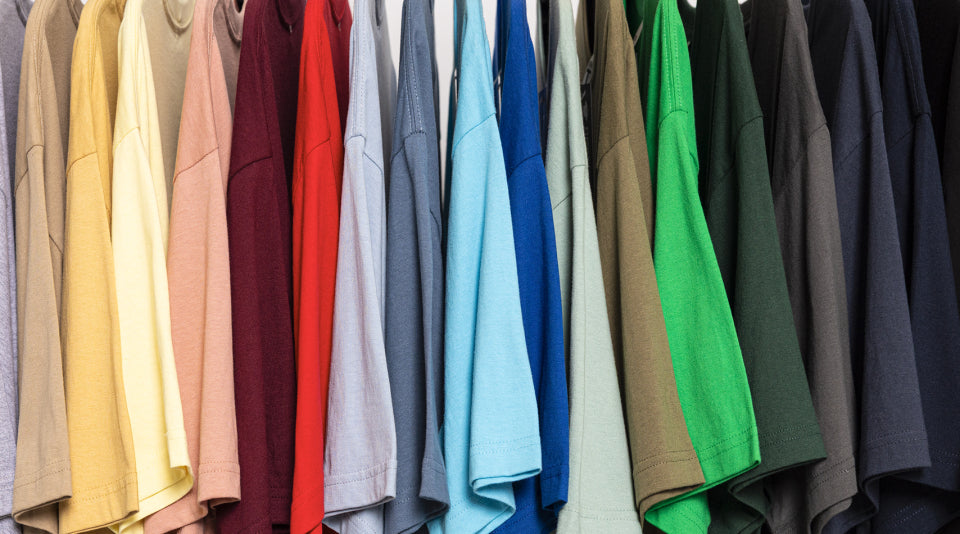A t-shirt is always a t-shirt — there’s not much to think about, and there’s a reason they’re called “basics,” right? Not exactly. Take a closer look and you’ll notice right away there’s more to this wardrobe essential than meets the eye. Short sleeve or long? V-neck, crew, scoop neck, or Henley? Raglan or set-in sleeve style? The little details play a major part when it comes to style and fit, but they’re only part of the picture.
Before any other decisions can be made, it’s critical to think about the element that defines the rest of the garment — the fabric it’s made from. Just like the shirt itself, what seems simple on the surface is much more complex in reality, as material choice directly impacts how it fits, feels, and performs.
100% Cotton, aka the “Classic Canvas”

Cotton has been part of the t-shirt’s DNA since the beginning in the early 1900s. Long before synthetic fibers and performance fabrics entered the picture, it set the standard of comfort and style that still holds over a century later. And even with decades of material innovations, cotton isn’t at risk of losing ground any time soon.
For starters, it is incredibly comfortable. The more it’s worn and washed, the softer it gets. Before long, one of our 100% cotton t-shirts develops that legendary, perfectly broken-in fit that feels like it was made just for you.
On top of its classic fit and feel, cotton is breathable and absorbent, which is why it was the material of choice when tees were functional undershirts instead of the style mainstays they are today.
For all its benefits, a cotton shirt isn’t without downsides. As anyone who has ever tossed a 100% cotton garment in the dryer or accidentally washed it in a hot water cycle knows, it’s susceptible to shrinking. Furthermore, the same characteristics that deliver a “just right” worn-in feeling that so many people crave also make it prone to wrinkling. Over time, it can lose its shape and may show wear more than other options (some people love the distressed look of cotton that’s been lived in, though).
For designers and printers, cotton is easy to work with, especially for Direct to Garment printing that relies on ink being absorbed into the fabric to create detailed, long-lasting images. Our 100% cotton 3600 collection is the industry standard for premium, ringspun cotton tees for a clean, reliable blank for virtually any decoration.
CVC Blends, aka the “Modern Workhorse” Material

You may be asking yourself, “What does CVC mean?” CVC stands for “Chief Value Cotton,” an appropriate name for a long-lasting, budget-friendly alternative to all-cotton and premium tri-blend fabrics. That explanation may, in turn, spark further questions about what this fabric is.
CVC fabric is a blend of cotton and polyester, typically around 60% cotton and 40% polyester, that delivers an extremely touchable hand feel with unbeatable durability. The combined benefits of both materials mean Chief Value Cotton is ideal for applications where comfort and performance are top priorities, as polyester fibers help tees retain their shape and color over time, while cotton maintains softness for livable daily wear.
Because of its partial synthetic composition, it’s not as breathable as 100% cotton. However, it does offer a few advantages that cotton lacks. A CVC shirt resists shrinking and wrinkling, stands up well to repeated washing, and costs less than more complex blends. The result is a fabric that performs reliably in a range of everyday situations without feeling stiff or uncomfortable.
For decorators, CVC fabric is a reliable middle ground between classic cotton and premium blends. It takes screen and DTG printing well, though the heathered surface may slightly mute solid-color prints. Still, for most designs, the print quality is sharp and lasting, and the surface gives a subtly textured appearance that many brands love.
Our CVC collection is a supremely wearable choice that won’t break the bank or sacrifice quality in pursuit of printability, making it a go-to fabric for everything from branded company shirts to casual everyday apparel.
Ultra-Premium Tri-Blend Fabric

The term “tri-blend” tells you everything about this material — it’s a blend of cotton, polyester, and rayon, typically made with 50% cotton/25% polyester/25% rayon, though the exact percentages can vary depending on the manufacturer. The result? Unbelievable softness, an airy and lightweight feel, and a slight stretch that naturally drapes and moves with your body. It wicks moisture away from the skin and dries quickly, unlike cotton. It’s wrinkle resistant like polyester, but more breathable, too. It’s no wonder, then, that tri-blend fabrics are popular with merchandisers and sportswear brands.
The premium composition and elevated performance of tri-blend fabrics come with a higher cost, and potentially more challenges to work around when it comes to decorating. The mixture of cotton, polyester, and rayon is responsible for the signature dappled (or “heathered”) appearance, which adds a subtle depth and vintage aesthetic but can impact how prints appear, as heat can damage the rayon fibers, while the fabric’s stretch can lead to distorted prints if the wrong methods are used.
With the right preparation and printing methods, tri-blend fabrics can achieve unique, high-quality prints. Some of the techniques that are well-suited for this fabric include:
- Screen printing: Works well with light ink deposits, soft-hand or low-bleed inks, and lower curing temperatures that protect the heat-sensitive rayon and keep the print flexible, while an underbase can boost color on the fabric’s slick surface.
- Digital printing (DTG): Delivers crisp detail on tri-blends but tends to look a bit softer and more muted since the ink bonds mostly to the cotton. Using specialized pretreatments and inks can help improve color and durability.
- Discharge printing: Lifts dye from the cotton and rayon fibers to leave an ultra-soft print. Because polyester doesn’t discharge, designs often take on a naturally faded, vintage look that pairs well with the fabric’s heathered texture.
- Heat transfer vinyl (HTV): Bonds to the fabric surface rather than soaking in, making it a dependable option. Stretch-friendly vinyl and lower press temperatures help preserve the fabric’s drape and prevent scorching.
Our premium Tri-Blend collection looks good and feels better, no matter what you’re doing, from relaxing at home on the weekend to working up a sweat during a high-intensity interval training (HIIT) session.
How Cotton, CVC, and Tri-Blend Stack Up
Sometimes, seeing your options side-by-side can make the selection process easier. We’ve broken down the variables across the three material types to simplify the decision.
|
Fabric |
Feel |
Printability |
Relative Price |
Best Uses |
|
100% Cotton |
Soft, classic, very breathable |
Excellent: bright, crisp prints (ink absorbs fully) |
$$ (affordable) |
Classic casual tees, summer apparel, band merch |
|
CVC Blend |
Soft like cotton but slightly denser |
Very Good: ideal for DTG and screen printing, though colors may appear muted |
$ (budget-friendly) |
Everyday/work shirts, promotional tees, casual wear |
|
Tri-Blend |
Ultra-soft, lightweight, with premium drape |
Excellent (if using soft/discharge inks); yields a “vintage” print style |
$$$ (premium) |
High-end fashion/athletic tees, boutique apparel |
Choosing the Right Material for Your Tee
Cotton is a timeless choice for comfort and printing flexibility. CVC provides wallet-friendly durability. Tri-blend brings the best of the three materials for premium style and performance. There’s no universal “right material” for every tee, only the right material for what you’re looking for in a tee.
Next Level Apparel makes it easy to find the right fabrics and styles. Contact us to start your next apparel order or learn more about the materials we offer.
Common Questions About T-Shirt Fabrics
What is the best fabric choice for a premium, ultra-soft feel?
For that unbelievably soft, premium feel, our Tri-Blend material is the way to go. The unique mix of cotton, polyester, and rayon creates a lightweight fabric with a slight stretch that drapes perfectly. It’s the go-to for high-end fashion, athletic apparel, or any situation where a luxurious, lived-in feel is the goal.
What is the best fabric for DTG printing?
For the sharpest, most vibrant DTG prints, you can’t beat cotton. We call it the "Classic Canvas" for a reason — its natural fibers absorb ink perfectly for crisp, detailed images that pop. Our 100% cotton 3600 collection is an industry standard for premium tees that provide a clean, reliable surface for decoration.
What is the most durable t-shirt material that's also comfortable and affordable?
The CVC (Chief Value Cotton) blend is the "Modern Workhorse” that combines comfort and durability at an affordable price point. Cotton means it’s incredibly soft, while polyester delivers wrinkle-free, wash-and-wear convenience, making it a reliable and long-lasting option for branded company shirts or promotional tees.






Leave a comment
All comments are moderated before being published.
This site is protected by hCaptcha and the hCaptcha Privacy Policy and Terms of Service apply.